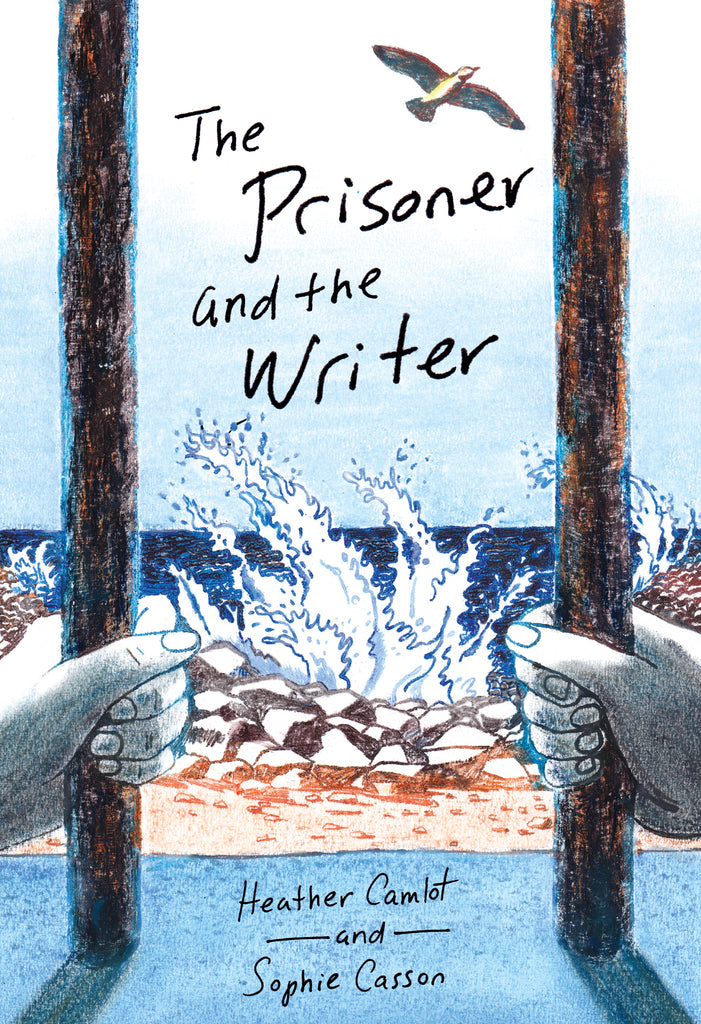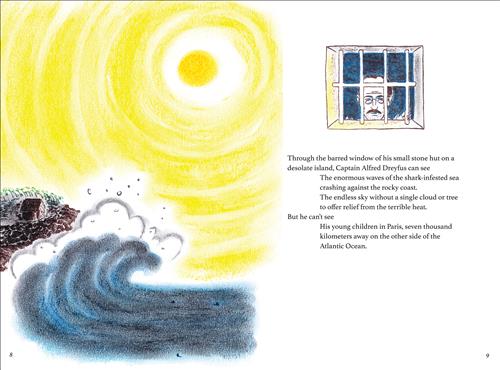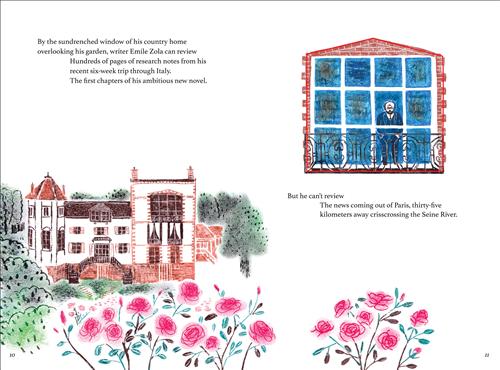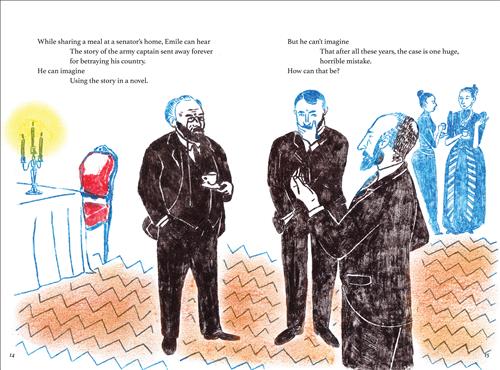Winner, Canadian Jewish Literary Awards Best Children's Book
When a Jewish army captain is falsely accused of treason and sent to prison, a writer uses his pen to fight for justice.
In 1895 a prisoner watches the ocean through the bars of his cell. Accused of betraying France, Captain Alfred Dreyfus is exiled to a prison on Devil’s Island, far from his wife and children. It’s a horrible fate — but what if he’s innocent?
Seven thousand miles away, the famous writer Emile Zola wonders: Is Alfred a traitor to France? Or a victim of antisemitism? Convinced that Alfred is innocent, Emile knows that it is his DUTY to help. He pens the famous letter “J’Accuse …!”, explaining that Alfred was blamed, charged, tried and convicted … only because he is Jewish.
This powerful middle-grade story written in verse with full-page illustrations is told from the perspectives of both Alfred Dreyfus and Emile Zola, two men whose courage changed the world. The true story of the Dreyfus Affair, published in time for the 125th anniversary of “J’Accuse …!”, acts as a reminder that a person committed to truth, justice and equality must stand up and speak out against prejudice for themselves — and for others. Includes an author’s note and further historical context.
Key Text Features
author's note
illustrations
sources
references
informational note
historical context
historical note
further information
afterword
headings
Correlates to the Common Core State Standards in English Language Arts:
CCSS.ELA-LITERACY.RL.4.3
Describe in depth a character, setting, or event in a story or drama, drawing on specific details in the text (e.g., a character's thoughts, words, or actions).
CCSS.ELA-LITERACY.RL.5.3
Compare and contrast two or more characters, settings, or events in a story or drama, drawing on specific details in the text (e.g., how characters interact).
CCSS.ELA-LITERACY.RL.5.7
Analyze how visual and multimedia elements contribute to the meaning, tone, or beauty of a text (e.g., graphic novel, multimedia presentation of fiction, folktale, myth, poem).
Winner, Canadian Jewish Literary Awards Best Children's Book
When a Jewish army captain is falsely accused of treason and sent to prison, a writer uses his pen to fight for justice.
In 1895 a prisoner watches the ocean through the bars of his cell. Accused of betraying France, Captain Alfred Dreyfus is exiled to a prison on Devil’s Island, far from his wife and children. It’s a horrible fate — but what if he’s innocent?
Seven thousand miles away, the famous writer Emile Zola wonders: Is Alfred a traitor to France? Or a victim of antisemitism? Convinced that Alfred is innocent, Emile knows that it is his DUTY to help. He pens the famous letter “J’Accuse …!”, explaining that Alfred was blamed, charged, tried and convicted … only because he is Jewish.
This powerful middle-grade story written in verse with full-page illustrations is told from the perspectives of both Alfred Dreyfus and Emile Zola, two men whose courage changed the world. The true story of the Dreyfus Affair, published in time for the 125th anniversary of “J’Accuse …!”, acts as a reminder that a person committed to truth, justice and equality must stand up and speak out against prejudice for themselves — and for others. Includes an author’s note and further historical context.
Key Text Features
author's note
illustrations
sources
references
informational note
historical context
historical note
further information
afterword
headings
Correlates to the Common Core State Standards in English Language Arts:
CCSS.ELA-LITERACY.RL.4.3
Describe in depth a character, setting, or event in a story or drama, drawing on specific details in the text (e.g., a character's thoughts, words, or actions).
CCSS.ELA-LITERACY.RL.5.3
Compare and contrast two or more characters, settings, or events in a story or drama, drawing on specific details in the text (e.g., how characters interact).
CCSS.ELA-LITERACY.RL.5.7
Analyze how visual and multimedia elements contribute to the meaning, tone, or beauty of a text (e.g., graphic novel, multimedia presentation of fiction, folktale, myth, poem).
| Published By | Groundwood Books Ltd — Oct 4, 2022 |
| Specifications | 64 pages | 6 in x 8.875 in |
| Keywords | prejudice; Jewish history; historical figure; propaganda; racism; the french dispatch; germinal; an officer and a spy 2019; affair; honore de balzac; victor hugo; characters who write; different points of view; writing letters; |
|
Supporting Resources
(select item to download) |
Teacher's Guide |
| Written By |
HEATHER CAMLOT is the author of the nonfiction What If Soldiers Fought with Pillows? and the Skipping Stones Honor Award novels The Other Side and Clutch, the latter of which was named among Kirkus’s Best Middle-Grade Historical Fiction. A journalist for more than 20 years, she has written, edited and translated for various publications, including Quill & Quire, Owl, TV Guide Canada and Style at Home. She lives in Toronto, Ontario. |
| Illustrated by |
SOPHIE CASSON has illustrated The Artist and Me by Shane Peacock, a finalist for the Marilyn Baillie Picture Book Award, Quelle pagaille! by Danielle Marcotte and Laurence-Aurélie Théroux-Marcotte, a finalist for the Governor General’s Award, and Helen’s Birds by Sara Cassidy. Her highly acclaimed illustrations are inspired by Japanese woodblock prints and World War II–era posters. Sophie’s award-winning work has also appeared in the Globe and Mail, the New York Times, Financial Times, Los Angeles Times and Nature, as well as in the Canadian Museum for Human Rights. Sophie lives in Montreal, Quebec. |
| Written By |
|
HEATHER CAMLOT is the author of the nonfiction What If Soldiers Fought with Pillows? and the Skipping Stones Honor Award novels The Other Side and Clutch, the latter of which was named among Kirkus’s Best Middle-Grade Historical Fiction. A journalist for more than 20 years, she has written, edited and translated for various publications, including Quill & Quire, Owl, TV Guide Canada and Style at Home. She lives in Toronto, Ontario. |
| Illustrated by |
|
SOPHIE CASSON has illustrated The Artist and Me by Shane Peacock, a finalist for the Marilyn Baillie Picture Book Award, Quelle pagaille! by Danielle Marcotte and Laurence-Aurélie Théroux-Marcotte, a finalist for the Governor General’s Award, and Helen’s Birds by Sara Cassidy. Her highly acclaimed illustrations are inspired by Japanese woodblock prints and World War II–era posters. Sophie’s award-winning work has also appeared in the Globe and Mail, the New York Times, Financial Times, Los Angeles Times and Nature, as well as in the Canadian Museum for Human Rights. Sophie lives in Montreal, Quebec. |
| Audience | ages 9 and up / grades 4 and up |
| Key Text Features | author’s note; illustrations; sources; references; informational note; historical context; historical note; further information; afterword; headings |
| Common Core |
CCSS.ELA-LITERACY.RL.5.3
CCSS.ELA-LITERACY.RL.5.7 CCSS.ELA-LITERACY.RL.4.3 |
Commended, Junior Library Guild Selection, 2021
Winner, Canadian Jewish Literary Awards Best Children's Book, 2023
An affecting account of the Dreyfus Affair that highlights the importance of acting against injustices. STARRED REVIEW
” —ForewordShort, forceful verses from Camlot (What If Soldiers Fought with Pillows?) pair with textured portraiture and landscapes by Casson (Helen’s Birds)—oil pastel monoprints with soft pastel—to pull readers into this story based on France’s Dreyfus affair.
” —Publishers WeeklyReaders will see echoes of current events in this scandalous story of 1890s antisemitism, bias, and the role of upstanders in confronting prejudice.
” —BooklistA small but powerful book that … works on many different levels and can be an important tool in discussions with older students.
” —The International Educator BlogCamlot’s brief, poetic text emphasizes the horrible conditions under which Dreyfus was imprisoned, the rampant anti-Semitism prevalent in France, and the personal consequences Zola suffered for his defense of Dreyfus. … Casson’s pastel illustrations … emphasize setting details and feature numerous views of the characters that emphasize their strongly felt emotions.
” —CM: Canadian Review of MaterialsIllustrated in dominating tones of black, blue, and red, it’s the occasional bursts of yellow depicting sources of light that remind us that hope is still alive, even during the darkest of times. … A soul-stirring story that is just as moving visually, The Prisoner and the Writer is well worth the read, and is a great introduction to developing young readers’ critical thinking skills.
” —Montreal Review of BooksBeautifully illustrated, [The Prisoner and the Writer] is a vividly written parable for today’s age of misinformation. The concept is carefully formed and powerfully executed. … A delight and a uniquely valuable book for today’s world.
” —Historical Novel SocietyBeautifully illustrated and easy to understand, The Prisoner and the Writer caters to young readers who may be encountering this piece of history for the first time. … Written in compelling verse, [it] opens up many themes for important educational discussion.
” —Jewish Book Council



